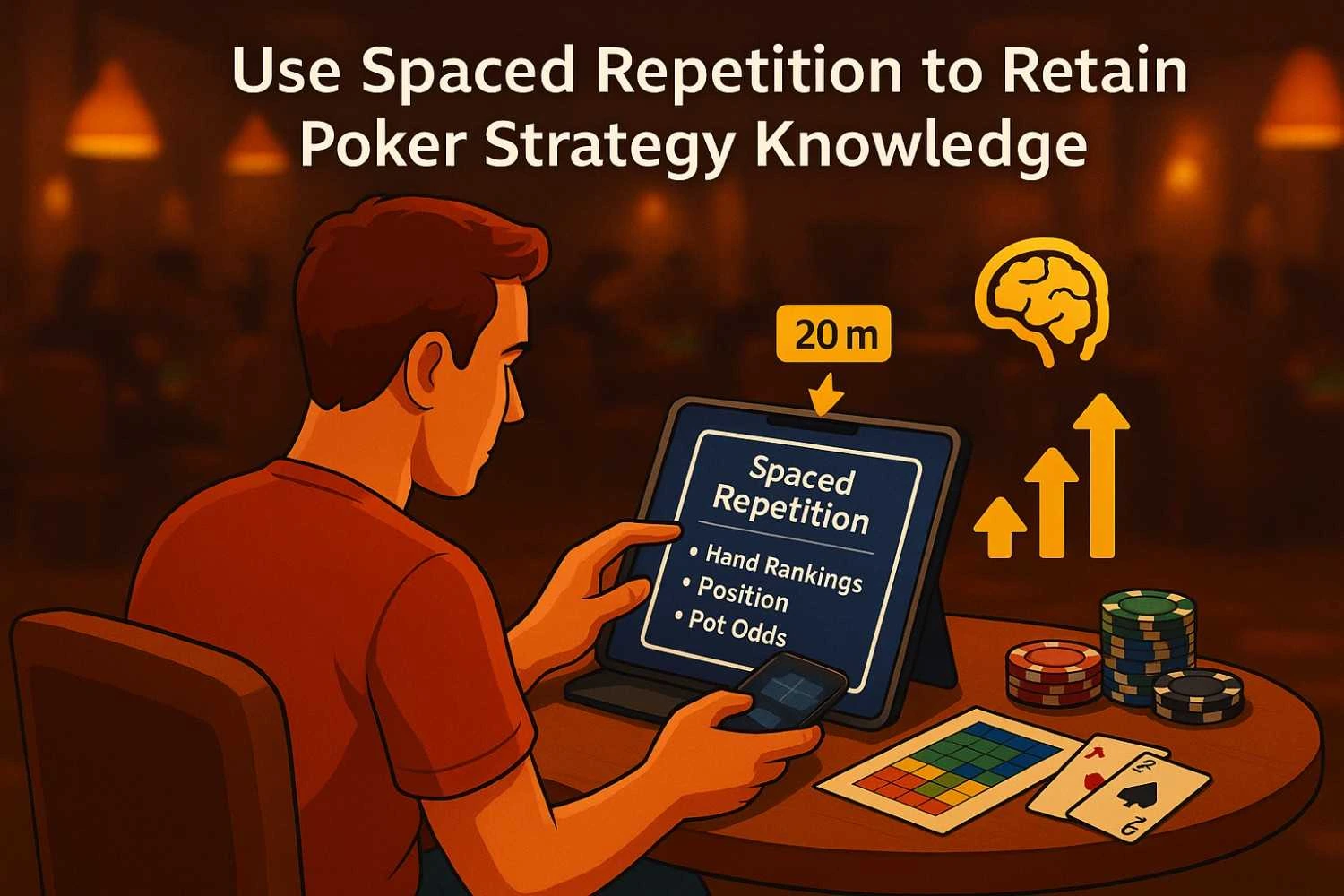
Ever felt like you studied a concept yesterday, only to stare at your screen today, wondering where it went? You’re not alone. Strategy knowledge tends to vanish right when you need it, especially when you’re juggling ranges, odds, mindset drills, and tricky board textures. That’s exactly where Spaced Repetition Poker steps in, quietly powerful and built for players who want more results with less stress.
This learning method doesn’t rely on cramming or forcing memory. Instead, it spaces out study just enough to help ideas actually stick. Players using this approach often realize something unexpected: they retain more while studying less.
Let’s skip the legal stuff and focus on what really matters: how to learn smarter, not harder. Ready to level up your study game?
How Spaced Repetition Poker Changes Long-Term Learning
Spaced repetition isn’t new, but it’s wildly effective. Instead of re-reading notes endlessly, you space your reviews so your brain sees the info right before it fades. That’s when learning becomes permanent.
When applied to poker, spaced repetition works wonders for remembering patterns, decision trees, hand ranges, and nuanced strategy shifts. Those “hmm, what do I do here?” moments start turning into confident choices.
Why Spaced Repetition Poker Works When Other Methods Fail
Ever read the same thing ten times and still forget it the next day? That’s your brain rejecting the info because it wasn’t reinforced the right way.
Spaced repetition does it differently. It nudges your memory when you’re just about to forget. That moment where it almost slips is where learning becomes cemented.
Let’s compare:
Traditional Study:
- Overload of notes
- Highlight everything
- Feel busy but retain little.
Spaced Repetition:
- Brief sessions
- Timed reinforcement
- Concepts become second nature..
At Bluffing Monkeys, we lean into this method because it mirrors how real learning actually works efficient, flexible, and built for long-term recall.
The Science of Spacing Your Learning
Behind the scenes, this method takes advantage of how memory fades and returns stronger with each timely review. Each time you come back to a concept, it takes longer to forget until eventually, you don’t forget at all.
With repetition cycles spaced out smartly, you’ll:
- Remember longer
- Recall faster
- Study less overall
It’s like muscle memory for your brain.
Build a Poker Study System Using Spaced Repetition
Let’s keep it simple. You don’t need fancy; just structure, curiosity, and consistency.
1. Slice Strategy Into Small Segments
Avoid info overload. Break things down:
- Hand categories
- Position-specific actions
- Range splits
- Board texture reactions
Each micro-topic becomes a flashcard.
2. Turn Concepts Into Questions
Get curious. Make every card a challenge:
- “Which hands probe turn after a flop check?”
- “Which combos semi-bluff turn on low-mid boards?”
- “What’s the check-raise plan from SB on dry textures?”
Framing these kinds of questions is how memory gets built and reinforced. Inside the Club List, many players even share their custom decks to challenge each other and track progress together.
3. Create a Poker Flashcard System
Use any format you like: apps, spreadsheets, or index cards. For each one:
- Situation
- Question
- Short, clear answer
- Optional explanation
That’s your poker flashcards spaced repetition system in action.
4. Schedule Your Review Cycle
A proven schedule looks like:
- Day 0: Learn
- Day 1: Review
- Day 3: Review
- Day 7: Review
- Day 14: Review
- Day 28: Review
Stick to it. Trust the system.
5. Track the Tough Spots
Flag hard concepts. Review them more often. Let the easier ones rest longer.
Flashcards That Actually Work
Example 1
Q: Which hands often check back on dry paired boards?
A: Medium-strength hands without protection needs.
Example 2
Q: Which combos shift from raise to call on monotone flops?
A: Vulnerable mid-strength hands with showdown value.
Example 3
Q: Which hands pick up bluff equity on low-connected turns?
A: Draws gaining turn equity like gutters and straight draws.
Poker Spaced Repetition Training: Make It a Routine
A good system isn’t overwhelming; it’s consistent. Here’s a sample routine:
Daily – 10 minutes
- Review 10 old cards
- Add 1–2 new ones
Weekly – 1 hour
- Focus on one topic
- Turn notes into new flashcards
Monthly – 30 minutes
- Review and update the deck
- Remove outdated or easy cards
With this plan, poker spaced repetition training becomes a habit, not a hassle.
Spaced Repetition for Poker Study: Why Less Is More
Many players burn out by over-studying in short sprints. But spaced repetition proves that showing up daily in small chunks beats those marathon sessions every time.
When you keep it consistent, here’s what happens:
- Faster recognition of spots
- Cleaner recall
- Less mental fatigue
- Sharper in-game thinking
No need to “grind study.” Just keep moving steadily.
Biases That Quietly Sabotage Your Memory
Sometimes, forgetting isn’t about discipline; it’s about bias. Watch out for:
- Confirmation bias: Studying what you already know
- Overconfidence: Thinking you remember without testing
- Availability bias: Recalling rare spots, not common ones
- Anchoring: Clinging to outdated ideas
Spaced repetition helps you catch and correct these before they mess with your strategy.
Turn Study Into a Habit, Not a Drag
Studying theory can feel heavy. But it doesn’t have to. Keep it engaging and lightweight.
Make it fun:
- Use colors or emojis
- Turn concepts into “boss cards”
- Track streaks
- Change locations
- Balance heavy theory with fun drills
You’re teaching your brain that it should feel rewarding.
Want to Boost Your Memory Even More?
Here are five bonus tools you can stack on top:
- Active Recall: Think of the answer before flipping the card.
- Dual Coding: Use visuals, diagrams, or color codes.
- Interleaving: Mix multiple topics in each session.
- Scenario Testing: Turn spots into “If X, then Y” logic trees.
- Self-Explanation: After you recall, explain why it’s right.
These layers push your brain into deep learning mode.
How It Helps Under Pressure
Pressure makes memory disappear unless you’ve already locked it in. With spaced repetition, the recall becomes automatic. No fumbling, no guessing. Just smooth decision-making, even in tough spots.
Can You Use It Outside Poker?
Absolutely. High-load fields like Bail Law, coding, or procedures all use similar methods to help professionals master complex info.
It works because:
- Flashcards clarify big ideas
- Timed review builds recall
- Questions replace passive notes
- Recall grows stronger over time
The brain loves structure; spaced repetition gives it that.
Common Pitfalls to Avoid
Don’t trip over these rookie mistakes:
- Too much info per card – Keep it tight.
- Reviewing too soon – Let forgetting kick in first.
- Skipping tough cards – Lean into what’s hard.
- Never updating the deck – Old info = wasted reps.
FAQs
- How long does spaced repetition take to show results?
You’ll usually start noticing stronger recall within 1–2 weeks. The deeper the concept, the more reviews it needs, but progress builds fast with consistency. - Do I need a special app to use spaced repetition?
Not at all. While digital flashcard apps can help, a simple system using paper cards or notes works just as well. - How many flashcards should I study per day?
Start with 5–15 cards. Focus on quality, not volume. A few well-reviewed cards daily beat overwhelming sessions. - Can spaced repetition help with memorizing decision trees?
Definitely. Breaking trees into smaller “if-this-then-that” cards makes each branch easier to internalize over time. - How do I avoid burnout with regular study?
Keep your sessions short and fresh. Change up environments, mix topics, and set goals you can actually stick with. Small daily wins are better than big weekly struggles.
Conclusion
Mastering poker strategy doesn’t have to feel like a constant uphill battle. With Spaced Repetition Poker, you’re tapping into the way your brain naturally prefers to learn through rhythm, recall, and regular review. Whether you’re memorizing ranges, solidifying decision patterns, or refining your hand reading, this method helps everything stick.
It’s not about working harder, it’s about working smarter. Spaced repetition takes what you already know, strengthens it with time, and turns it into instinct at the table. Over time, your study turns from effort into edge.
So don’t just study, retain, apply, and evolve. The game keeps changing, and now, so can your learning.
